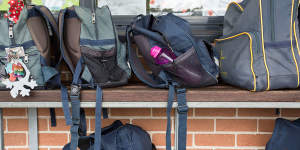The Catholic Schools NSW submission to said the sector – like public schools – is already suffering shortages in certain locations,such as regional areas,and in subjects such as mathematics.
The NSW Catholic system runs almost 600 schools,employs 27,000 teachers and educates 256,000 students. Its teachers are required to operate within a religious context,and more than half are trained at the Australian Catholic University and Notre Dame.

Catholic Schools NSW predicts a 15 per cent teacher shortage by 2030.Michele Mossop
Modelling done over the past two years shows “the Catholic sector in NSW will have a workforce shortfall of approximately 15 per cent by 2030,” the submission said. “The gaps are largely proportionate to those predicted for government schools.”
The NSW Department of Education is also predicting a shortage in the same regions and subjects and an overall shortage in five years,while the state’s 39 Anglican schools say they will need another 1700 teachers for new positions – plus replacements for those who retire or leave – in the next eight years.

Catholic Schools NSW chief executive Dallas McInerney.Supplied
A submission from the National Catholic Education Commission also raised concerns about a shortfall,as did a submission from the Victorian Department of Education and Training and another from the ACT government.
“There is strong reason to think that currently observed and forecast teacher shortages will be exacerbated,and Australian schools will increasingly find it difficult to employ the teachers they require,” the commission submission said.
The Catholic Schools NSW submission said attracting high-performing school leavers into teaching would require increasing the status and value of teaching in the community and more clearly defining teachers’ role and responsibilities.
“[Authorities also need to] modernise enterprise agreements,” it said. “Improve pay,conditions,and promotional opportunities.” Catholic Schools NSW boss Dallas McInerney also backed a one-year postgraduate teaching qualification.
Aspiring teachers can either study a four-year undergraduate degree,a five-year combined degree or a master’s degree,which takes about two years. A one-year graduate diploma was phased out from 2013 under a new national quality reform.
However,a joint submission from the Tasmanian government and the University of Tasmania said the reform had not worked.
“Since the introduction of the longer post-graduate courses there has not been any noticeable increase in teacher quality or student performance,” it said.
In NSW,the number of students beginning education degrees dropped by almost a third between 2014 and 2019. About half of students that begin,don’t finish,and 10 per cent leave teaching within six years of graduating.
The NSW Teachers Federation argues the problem cannot be fixed without better pay – in NSW,a classroom teacher’s salary does not grow beyond about $107,000 – and is campaigning for an across-the-board rise of between five and 7.5 per cent.
“The teacher shortage crisis is growing,putting the right of every child to be taught by a qualified teacher at risk,” said federation president Angelo Gavrielatos. “Uncompetitive pay and crippling workloads are the most significant disincentive in attracting and retaining the teachers we need.”
Carol Matthews,the acting secretary of the NSW branch of the Independent Education Union,said its survey last year showed significant shortages in rural and regional areas,and increasingly in metropolitan areas.
“Anecdotally at the moment things have got worse,” she said. “I would agree with the teacher federation’s general position,which is there are two main drivers - one is pay and the other is workload.”
However,Glenn Fahey from the Centre for Independent Studies,who published a report calledTeacher Workforce:fiction vs fact this week,disagreed that across-the-board pay rises were the answer to the problem.
“What we have is a teacher allocation problem,not a teacher numbers problem,” he said. “We have enough teachers overall. But we need more maths and science teachers. And we need to keep talent in the bush.”
The Morning Edition newsletter is our guide to the day’s most important and interesting stories,analysis and insights..